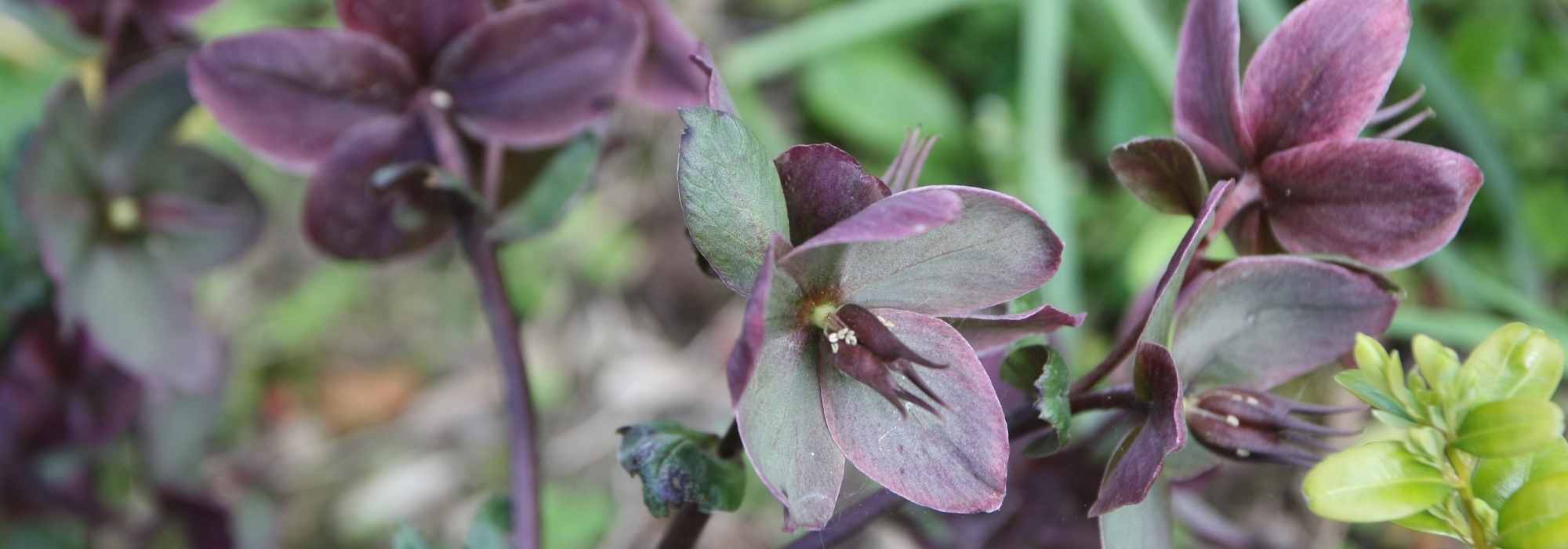
Oriental Hellebores: the darkest ones
Dare to try dark Lenten Roses: unusual, elegant, and sophisticated
Contents
Oriental Hellebores are among the most beautiful and longest-flowering plants in mid-winter. Chosen in dark colours, they offer a certain sophistication far removed from the softness of pastel shades. A little less natural but incredibly chic, these dark colours are strikingly effective, especially in pots accompanied by beautiful foliage or heathers. Red, purple, and even black are precious colours, particularly in Oriental Hellebores, which bloom slightly later than Christmas Roses. These deep hues should be used in sufficiently bright locations to avoid dulling their vibrancy and paired with zingy or very soft colours.
Discover some of our favourite dark oriental Hellebore varieties, featuring both single and double flowers.
Helleborus orientalis ‘Slaty Blue’
Here is a stunning hellebore that should captivate you as much as it does us, with its unique colour: a deep slate blue, subtly veined with plum. The pale green heart and light yellow stamens contrast beautifully against the dark, velvety petals. ‘Slaty Blue’ blooms between January and March, quite early for an Oriental hellebore, and retains its foliage all year round. Provide it with a partially shaded spot in humus-bearing soil (it can tolerate dryness, however). Its double-flowered version is logically called ‘Double Slaty Blue’, though it is slightly less natural-looking.
Surrounded by evergreen anise-scented foliage, echoing its heart, it shines for many months. A Helleborus x sternii will complement it beautifully, remaining discreet with its pistachio green flowers. Some low-growing purple botanical crocuses like Crocus tommasinianus will stay low enough not to compete, and the botanical fritillaries (Fritillarias liliacea) will delicately reveal its dark flowers.
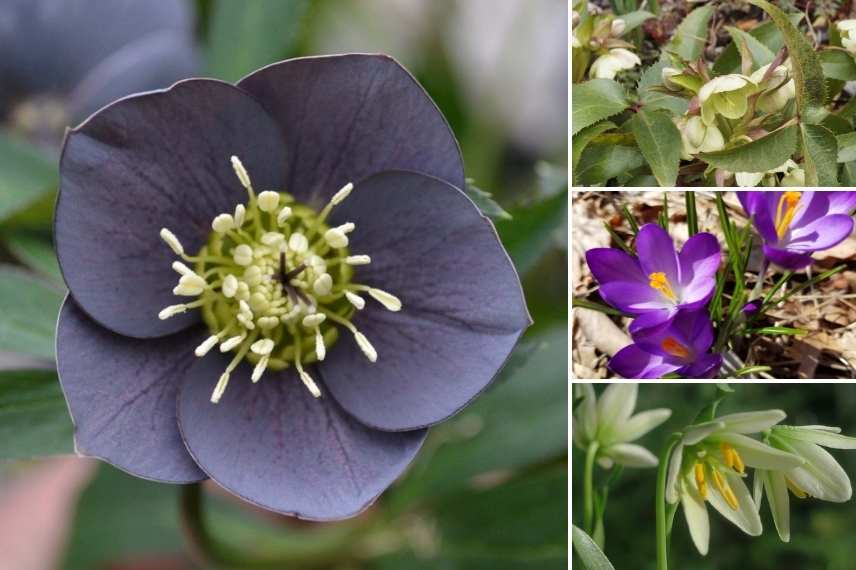
Helleborus orientalis ‘Slaty Blue’, Helleborus sternii, Crocus tomassinianus, Fritillaria liliacea
Read also
Hellebores: planting, growingHelleborus orientalis ‘Double Red’
If you love double-flowered hellebores, the Helleborus orientalis ‘Double Rouge’ or ‘Double Red’ is a little gem with its large, almost violet flowers, slightly frilled, giving them a lovely texture and a proud appearance. A bit taller than other varieties, reaching about 60 cm in height after a few years, it deserves a prime spot and companions worthy of its fiery beauty.
Pair it with foliage in similar shades, either lighter or darker, or a mix, such as a Heuchera ‘Bella Notte’ or for more contrast with the mauve-pink of a Heuchera ‘Berry Smoothie’, or even the marbled veins of the lovely ‘Plum Pudding’. Another simple hellebore with a collar, like the Helleborus ‘Anemone Pure White’, will support its flowering for a long time while illuminating it.
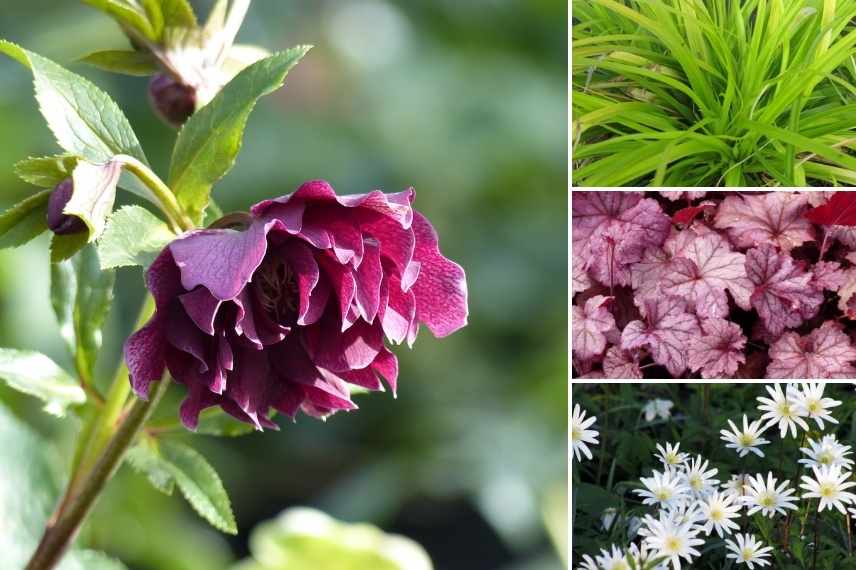
Oriental hellebore ‘Double Rouge’, here accompanied by a Carex oshimensis ‘Everillo’, Heucheras ‘Berry Smoothie’, and Anemone blanda
Discover other Helleborus - Hellebore
View all →Available in 0 sizes
Available in 0 sizes
Available in 1 sizes
Available in 2 sizes
Available in 2 sizes
Available in 2 sizes
Available in 1 sizes
Available in 0 sizes
Available in 1 sizes
Available in 1 sizes
Helleborus orientalis 'Black Chocolate'
Its evocative name does not deceive: the Helleborus orientale ‘Black Chocolate’ will delight all lovers of unusual flowering, with its enchanting chocolate hue that elegantly contrasts with the pale yellow, almost cream, stamens. The petals are single, and it is the purplish-brown colour flirting with black that captivates us. Its evergreen foliage is also of interest, as it takes on a much darker, almost bronze colour than other dark-flowered cultivars. This oriental hellebore is, like all those in this selection, lovely when grown in a slightly elevated pot to appreciate the unique beauty of its flowering, which spreads between February and April.
In the garden, it remains beautiful surrounded by another evergreen hellebore with pale green flowers, such as Helleborus Argutifolius. You can pair it with soft tones like the pink of an early Bergenia or the bright yellow of primroses, along with evergreen ferns like Polystichum polyblepharum, and a Euphorbia amygdaloides ‘Purpurea’. In a pot, a lovely pink heather is enough to highlight it.

Oriental hellebore ‘Black Chocolate’, stunning alongside an early Bergenia (‘Rosenkristall’) and evergreen foliage (Polystichum polyblepharum and purple wood spurge)
Read also
Hellebores: 7 successful pairing ideasHelleborus abchasicus or Abkhazian Hellebore
This somewhow unpronounceable hellebore boasts a stunning purplish-pink colour, neither too dark nor too dull, that deserves its place in this selection of dark oriental hellebores. For Helleborus abchasicus is a botanical species with single flowers, exhibiting beautiful elegance and a very natural appearance. Growing to about 40 cm like its counterparts, it strikes the perfect balance between a bold yet soft colour. It flowers for a long time, from February to April, allowing for numerous combinations: for example, an Hamamelis vernalis ‘Amethyst’ towering above it, and alongside it, to enhance its beauty, a concurrent purple flowering will support its variegation, such as that of the Snake’s Head Fritillaries, beautifully spotted. A few white heathers and the bright foliage of Carex elata ‘Aurea’ will complete the picture!

Helleborus abchasicus. On the right, Hamamelis vernalis ‘Amethyst’, a white heather, and Carex elata ‘Aurea’
Helleborus orientalis 'Black'
Certainly one of the darkest hellebores among the orientals, Helleborus orientale ‘Noire’ or ‘Black’ is a marvel of purity in form and rarity in its colour: it boasts a particularly dark shade, a deep purple edging on black, offering almost orange reflections when a ray of sunlight passes over it. Small in size, this divine hellebore willingly occupies borders or spaces beneath trees. Its deciduous foliage suggests a pairing with beautiful leaves. Yellow tones complement it beautifully, like a carpet of Eranthis hyemalis or some early daffodils like ‘Bridal Crown’. Surrounded by a beautiful mass of evergreen Ophiopogons and Hakonechloa macra, it also pairs very well with a pink-flowering bush, such as a fragrant and graceful Viburnum bodnantense.

Oriental hellebore ‘Noire’, Viburnum bodnantense, Ophiopogons and Hakonechloa macra
Helleborus orientalis ‘Double Black’
To conclude this selection… not exhaustive, Helleborus orientale ‘Double Black’ is another very elegant double-flowered cultivar. This hellebore showcases its delightful undulating petals, and this dark colour, wavering between purple and black, playing with a few metallic reflections when the winter sun lingers on it. It blooms like most Oriental hellebores between February and March, sometimes even earlier. This hellebore allows you to create very beautiful displays in pots on a terrace or balcony facing north, east, or even west: enhance its unique colour with some snowdrops and pale pink cyclamen, or with a heather or a gaultheria for example. In the garden, ‘Double Noire’ is divine surrounded by pastel or salmon tones: for instance, at the foot of a Japanese quince ‘Cameo’ that will accompany it in March-April, surrounded by a Daphne and other hellebores in cream to pink shades…
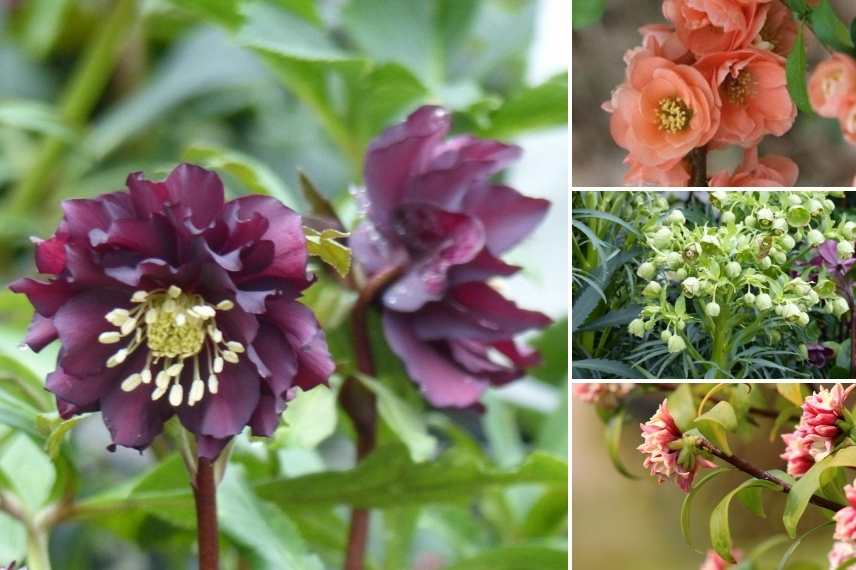
Hellebores ‘Double Noire’. A ‘Cameo’ quince, a Helleborus foetidus (here ‘Sopron’) and a Daphne bring soft, magical tones…
- Subscribe!
- Contents
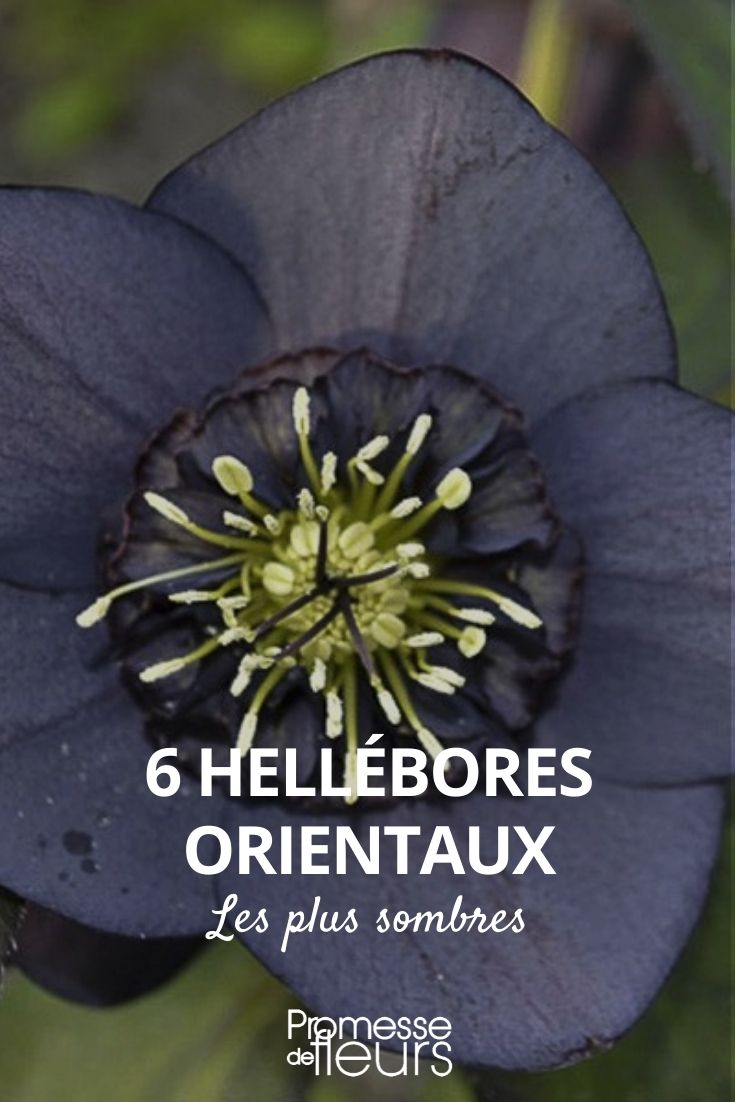































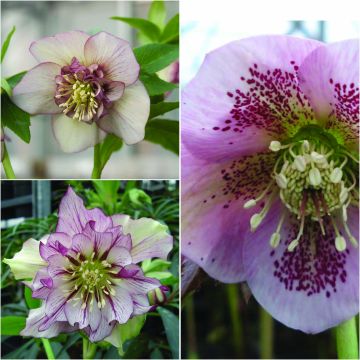
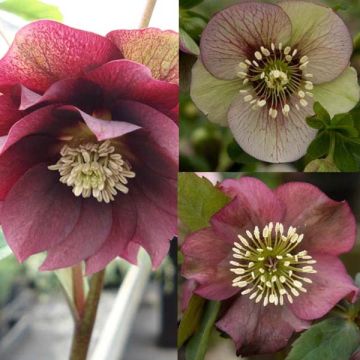
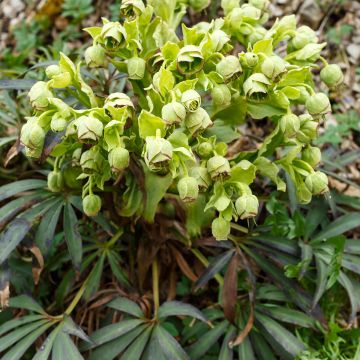
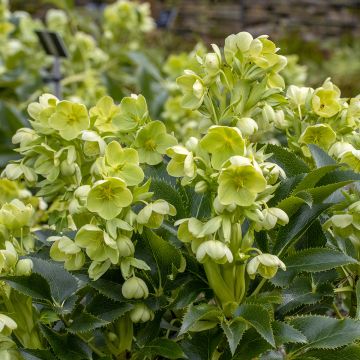
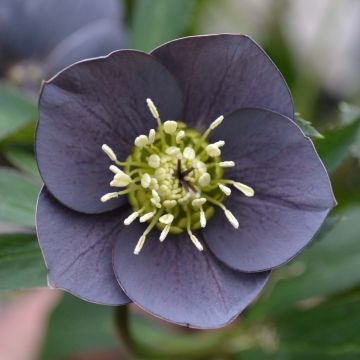
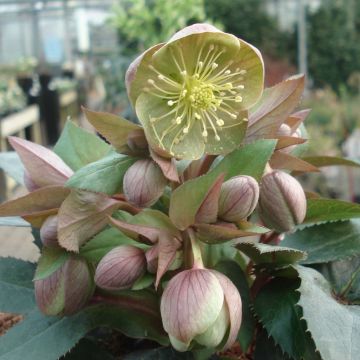
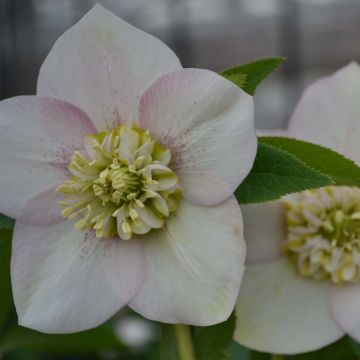

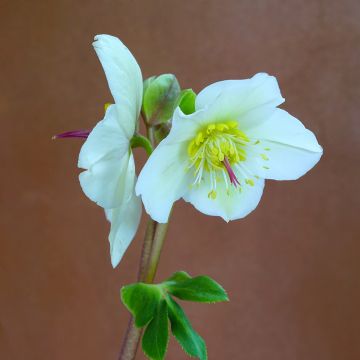
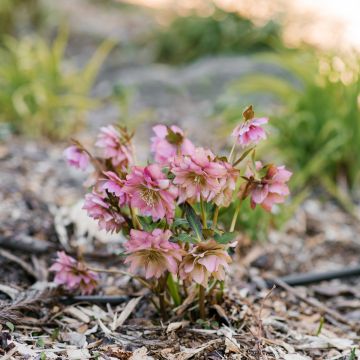
Comments